南方医科大学学报 ›› 2024, Vol. 44 ›› Issue (10): 1887-1897.doi: 10.12122/j.issn.1673-4254.2024.10.07
• • 上一篇
收稿日期:2024-05-18
出版日期:2024-10-20
发布日期:2024-10-31
通讯作者:
时广森
E-mail:2321976315@qq.com;shiguangsen@zidd.ac.cn
作者简介:宋梓萍,硕士,E-mail: 2321976315@qq.com
基金资助:
Ziping SONG1,2( ), Lei HAN2, Zhuochao LIN2, Guangsen SHI1,2(
), Lei HAN2, Zhuochao LIN2, Guangsen SHI1,2( )
)
Received:2024-05-18
Online:2024-10-20
Published:2024-10-31
Contact:
Guangsen SHI
E-mail:2321976315@qq.com;shiguangsen@zidd.ac.cn
Supported by:摘要:
目的 探究在限制性饮食和高脂饮食模式下,短睡眠Adrb1-A187V小鼠模型与其野生型小鼠行为活动的差异。 方法 将短睡眠基因小鼠分为常规饮食组、气味保留禁食组、完全禁食组、高脂饮食组。常规饮食组:小鼠代谢与行为监测系统中,Adrb1+/+ 小鼠25只和Adrb1+/m 小鼠26只。气味保留禁食组:小鼠代谢与行为监测系统中,Adrb1+/+小鼠17只,Adrb1+/m小鼠19只;EEG/EMG睡眠活动监测系统中,Adrb1+/+小鼠6只,Adrb1+/m小鼠6只。完全禁食组:小鼠代谢与行为监测系统中,Adrb1+/+小鼠6只,Adrb1+/m小鼠4~5只;EEG/EMG睡眠活动监测系统中,Adrb1 +/+小鼠6只,Adrb1+/m小鼠6只。高脂饮食组:小鼠代谢与行为监测系统中,Adrb1+/+小鼠6只,Adrb1+/m小鼠7只;EEG/EMG睡眠活动监测系统中,Adrb1+/+小鼠6只,Adrb1+/m小鼠6只。在两组小鼠颅骨上植入脑电/肌电电极,通过给予小鼠24 h气味保留禁食实验、完全禁食实验以及高脂饮食实验,检测其在不同进食模式下,小鼠如何改变行为活动以适应饮食环境的变化。 结果 在气味保留禁食实验中,Adrb1+/m 小鼠表现出更加稳定的运动水平的波动,活动相对较少(P<0.05),睡眠时间更长(P<0.01,P<0.05),有利于适应饥饿环境,具有更耐饿的特性;完全禁食实验中,Adrb1+/m 小鼠的夜间进水量更多(P<0.05),进水的生物节律性更好,表现出在进水方面出现的“少食多餐”。同时,非快速动眼睡眠(NREM)时长增加(P<0.01),可以帮助小鼠抵抗饥饿。高脂饮食实验中,Adrb1+/m 小鼠表现出更高的运动水平,表现为夜间站立次数和运动距离水平更高(P<0.0001),且快速动眼睡眠(REM)在白天增加(P<0.01)。 结论 Adrb1-A187V突变小鼠可更快速对环境变化做出反应,在限制性饮食条件中,通过增加睡眠减少能量消耗以维持能量稳态;在高脂饮食条件中,则保持更高的运动水平,与限制性饮食条件相反。
宋梓萍, 韩磊, 林卓超, 时广森. Adrb1-A187V突变短睡眠小鼠在不同饮食条件下的行为变化[J]. 南方医科大学学报, 2024, 44(10): 1887-1897.
Ziping SONG, Lei HAN, Zhuochao LIN, Guangsen SHI. Behavioral changes of transgenic mice carrying Adrb1-A187V mutation with short sleep duration under different dietary conditions[J]. Journal of Southern Medical University, 2024, 44(10): 1887-1897.
| Stage | Temperature (℃) | Time | Cycle |
|---|---|---|---|
| 1 | 95 | 3 min | 1× |
| 95 | 30 s | ||
| 2 | 60 | 30 s | 35× |
| 72 | 30 s | ||
| 3 | 72 | 5 min | 1× |
| 4 | 16 | ∞ | 1× |
表1 PCR 程序设定
Tab.1 PCR program setting
| Stage | Temperature (℃) | Time | Cycle |
|---|---|---|---|
| 1 | 95 | 3 min | 1× |
| 95 | 30 s | ||
| 2 | 60 | 30 s | 35× |
| 72 | 30 s | ||
| 3 | 72 | 5 min | 1× |
| 4 | 16 | ∞ | 1× |
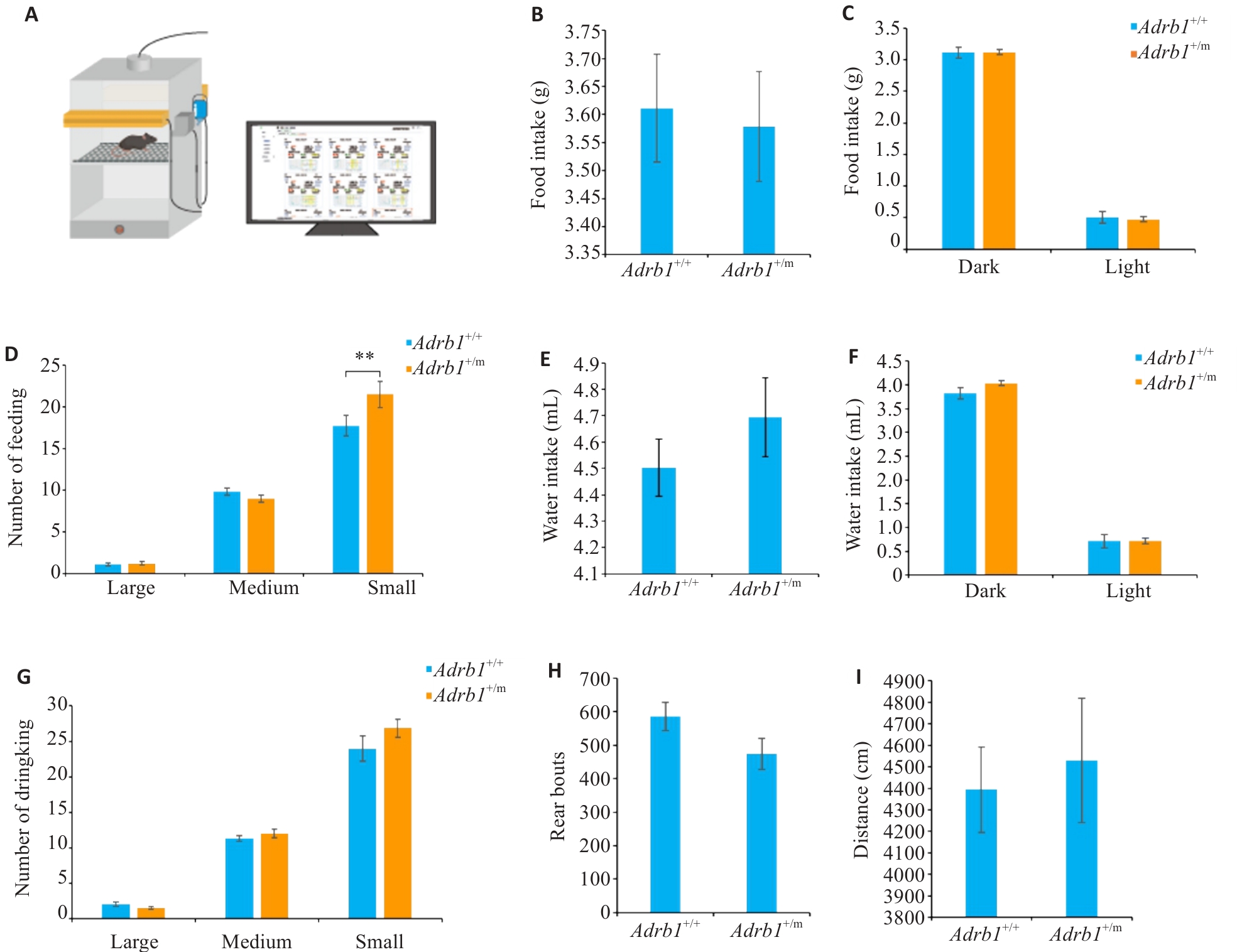
图1 常规饮食条件下Adrb1+/+ 和Adrb1+/m 小鼠的行为活动
Fig.1 Activity and food/water intake of Adrb1+/+ and Adrb1+/m mice with free access to normal chow. A: Schematic of the mouse behavioral and feeding/drinking recording system. B: Total daily amount of food intake of Adrb1+/+ and Adrb1+/m mice. C: Total amount of food intake of Adrb1+/+ and Adrb1+/m mice in the dark and light phases. D: Daily number of "big meal", " medium meal" and "small meal" in Adrb1+/+ and Adrb1+/m mice. E: Total daily amount of water intake of Adrb1+/+ and Adrb1+/m mice. F: Total amount of wake intake of Adrb1+/+ and Adrb1+/m mice in dark and light phases. G: Daily numbers of "big water", " medium water " and "small water " in Adrb1+/+ and Adrb1+/m mice. H: Total daily numbers of rearing of Adrb1+/+ and Adrb1+/m mice. I: Total daily distance traveled by Adrb1+/+ and Adrb1+/m mice. Adrb1+/+ mice (n=25), Adrb1+/m mice (n=26), **P<0.01.
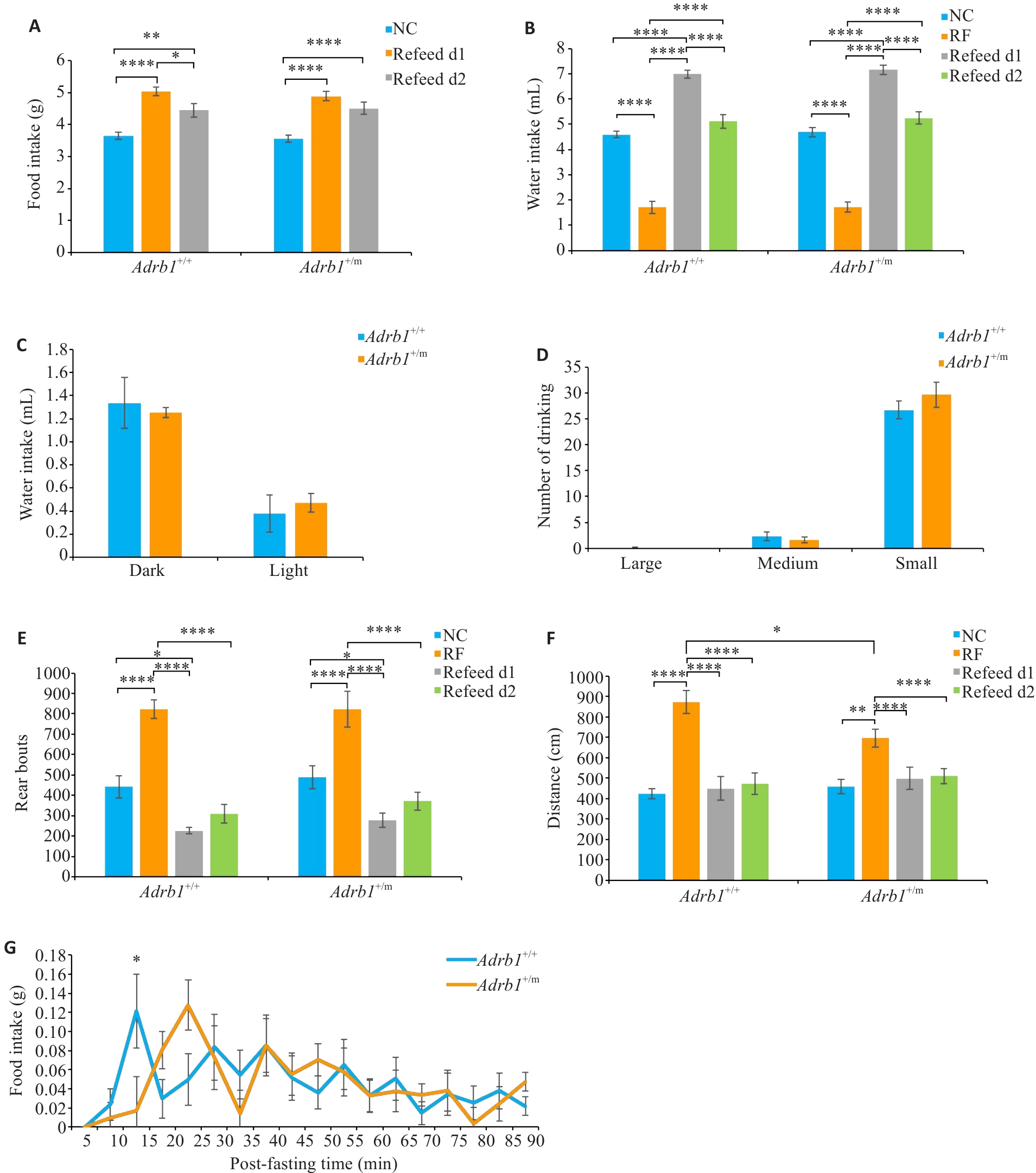
图2 气味保留禁食前后Adrb1 +/+ 和Adrb1 +/m 小鼠饮食和运动行为的变化
Fig.2 Changes in food intake and activity of Adrb1+/+ and Adrb1+/m mice during and after odor-retention fasting regime. A: Total daily food intake of Adrb1+/+ and Adrb1+/m mice during NC and Refeed. B: Total daily water intake of Adrb1+/+ and Adrb1+/m mice during NC, RF, and Refeed. C: Water intake of Adrb1+/+ and Adrb1+/m mice in the dark and light phase under RF conditions. D: Total daily number of "big water", "medium water " and "small water" of Adrb1+/+ and Adrb1+/m mice under RF conditions. E: Total daily number of rears of Adrb1+/+ and Adrb1+/m mice during NC, RF and Refeed. F: Total daily distance traveled by Adrb1+/+ and Adrb1+/m mice under NC, RF, and Refeed. G: Time course recording of food intake after odor retention fasting (RF) plotted every 5 min for 90 minu in Adrb1+/+ and Adrb1+/m mice. Adrb1+/+ mice (n=17), Adrb1+/m mice (n=19). NC: Normal condition; RF: Odor retetion fasting. *P<0.05, **P<0.01, ****P<0.0001.
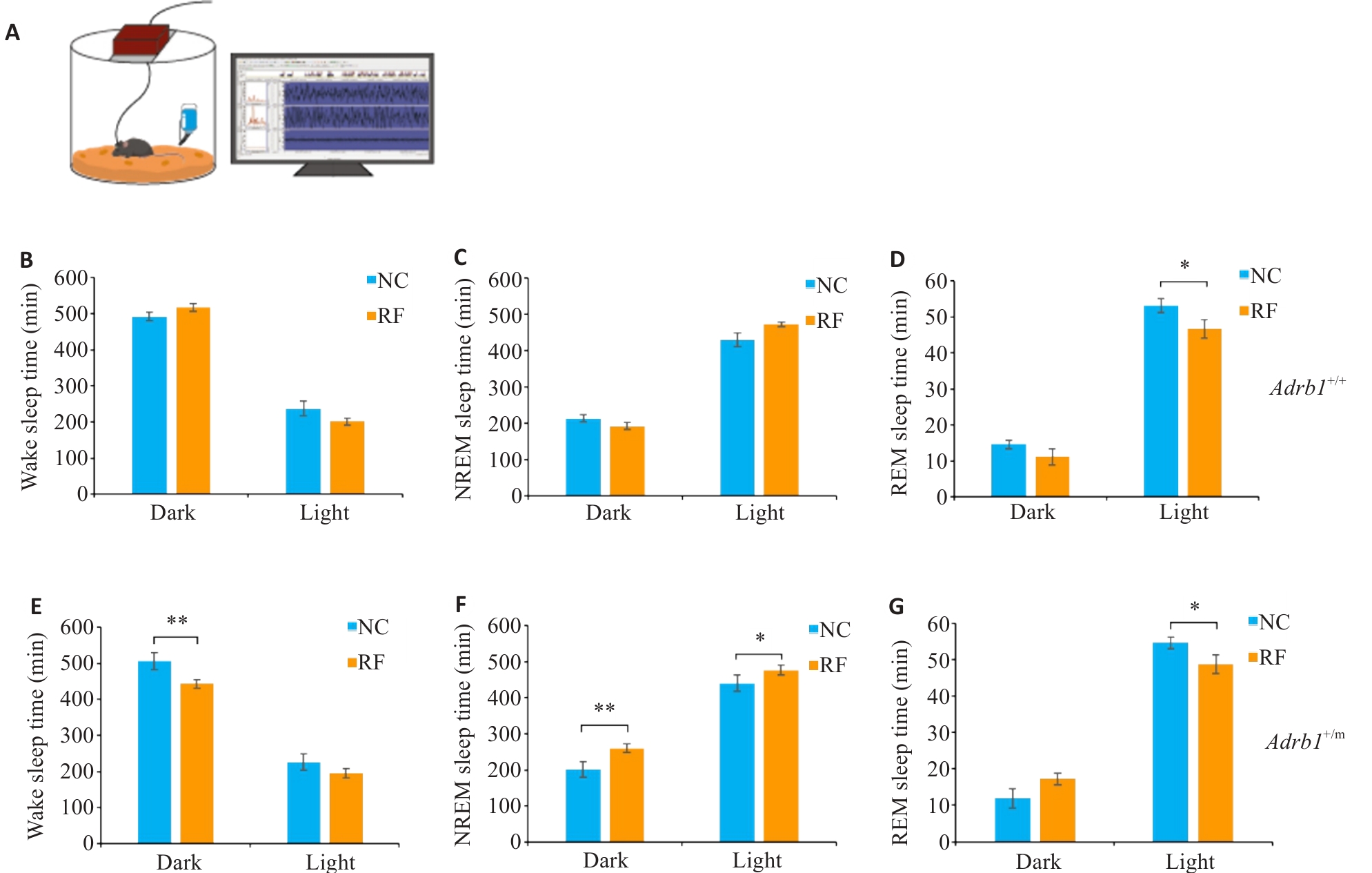
图3 气味保留禁食前后Adrb1 +/+ 和Adrb1 +/m 小鼠的睡眠活动变化
Fig.3 Sleep changes in Adrb1+/+ and Adrb1+/m mice under odor retention fasting condition. A: The multichannel EEG recording system. B-D: Total Wake (B), NREM (C), and REM (D) sleep time of Adrb1+/+ mice in the dark and light phase under NC and RF conditions. E-G: Total Wake (E), NREM (F), and REM (G) sleep time of Adrb1+/m mice in the dark and light phase under NC and RF conditions. Adrb1+/+ mice (n=6), Adrb1+/m mice (n=6), *P<0.05, **P<0.01.
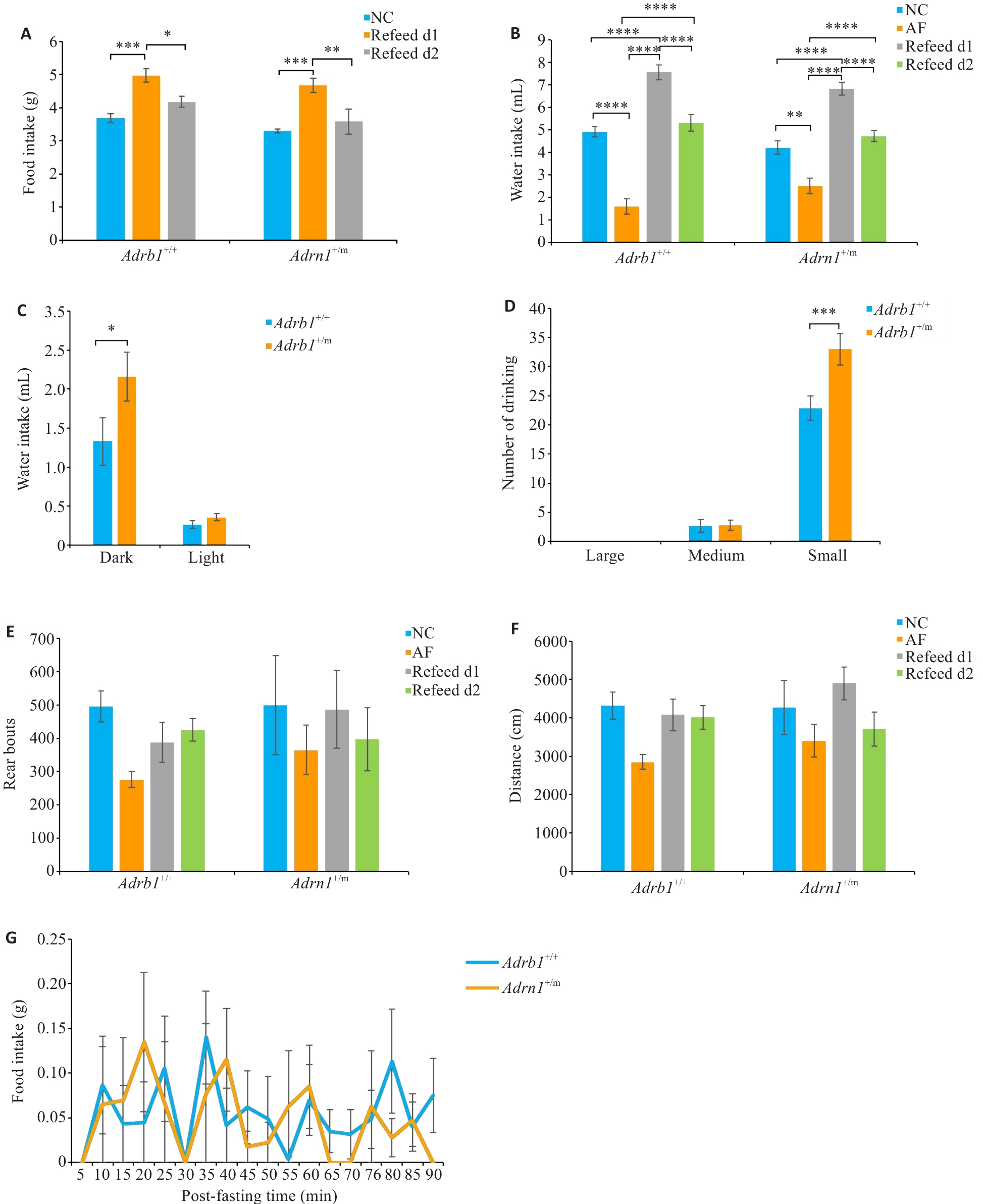
图4 完全禁食前后Adrb1 +/+ 和Adrb1 +/m 小鼠饮食和运动行为的变化
Fig.4 Changes in food intake and activity of Adrb1+/+ and Adrb1+/m mice during and after absolute fasting condition (AF). A: Total daily food intake of Adrb1+/+ and Adrb1+/m mice during NC and Refeed. B: Total daily water intake of Adrb1+/+ and Adrb1+/m mice during NC, AF, and Refeed. C: Water intake of Adrb1+/+ and Adrb1+/m mice in the dark and light phase under AF conditions. D: Total daily number of "big water", " medium water " and "small water " of Adrb1+/+ and Adrb1+/m mice under AF conditions. E: Total daily number of rears of Adrb1+/+ and Adrb1+/m mice during NC, AF and Refeed. F: Total daily distance traveled by Adrb1+/+ and Adrb1+/m mice under NC, AF, and Refeed. G: Time course recording of food intake after absolute fasting (AF) plotted every 5 min for 90 min in Adrb1+/+ and Adrb1+/m mice. Adrb1+/+ mice (n=6), Adrb1+/m mice (n=4-5), *P<0.05, **P<0.01, ***P<0.001, ****P<0.0001.
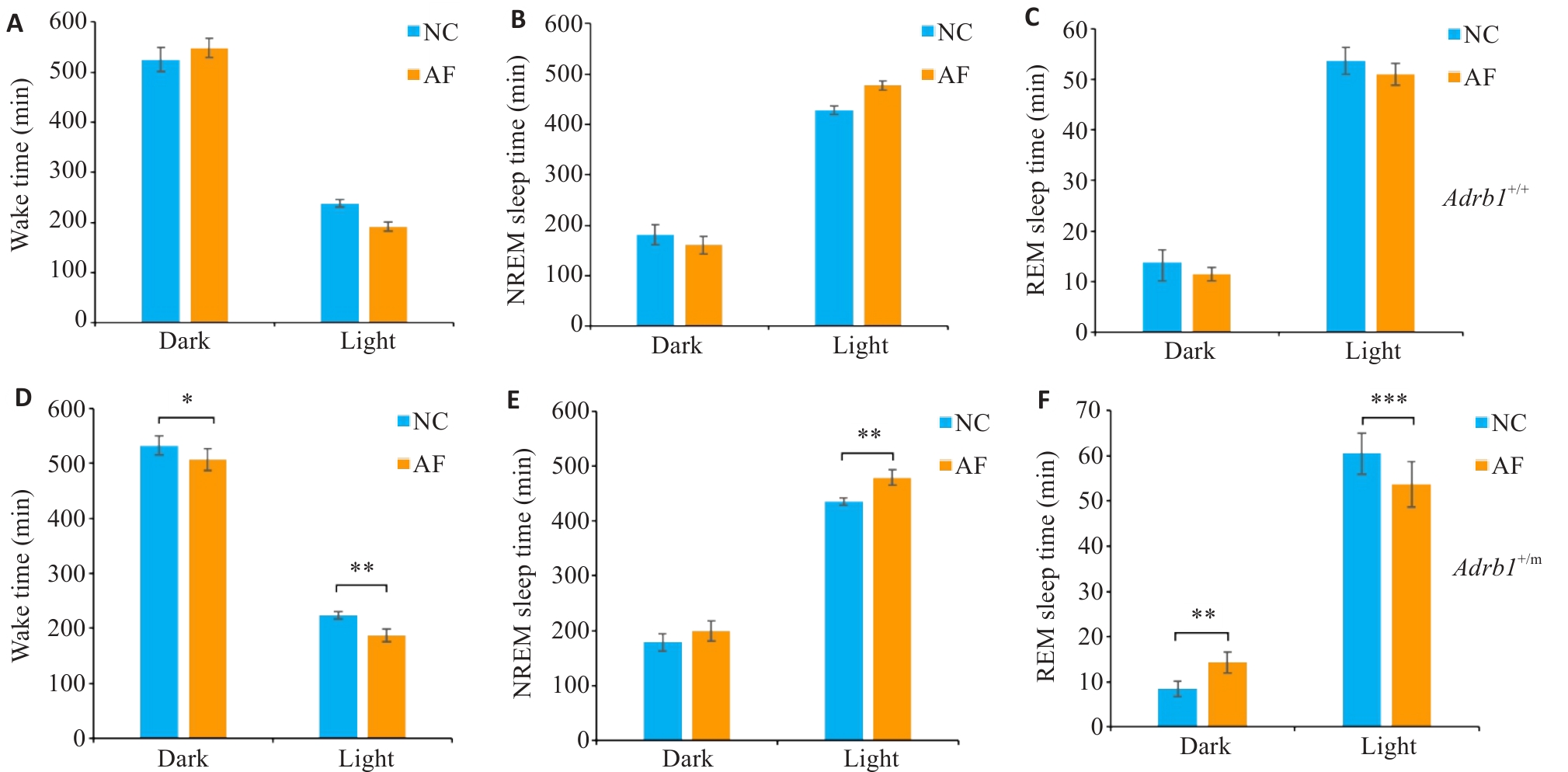
图5 完全禁食前后Adrb1 +/+ 和Adrb1 +/m 小鼠的睡眠活动变化
Fig.5 Sleep changes in Adrb1+/+ and Adrb1+/m mice under absolute fasting (AF) condition. A-C: Total Wake (A), NREM (B), and REM (C) sleep time of Adrb1+/+ mice in the dark and light phase under NC and AF conditions. D-F: Total Wake (D), NREM (E), and REM (F) sleep time of Adrb1+/m mice in the dark and light phase under NC and AF conditions. Adrb1+/+ mice (n=6), Adrb1+/m mice n=6), *P<0.05, **P<0.01, ***P<0.001.
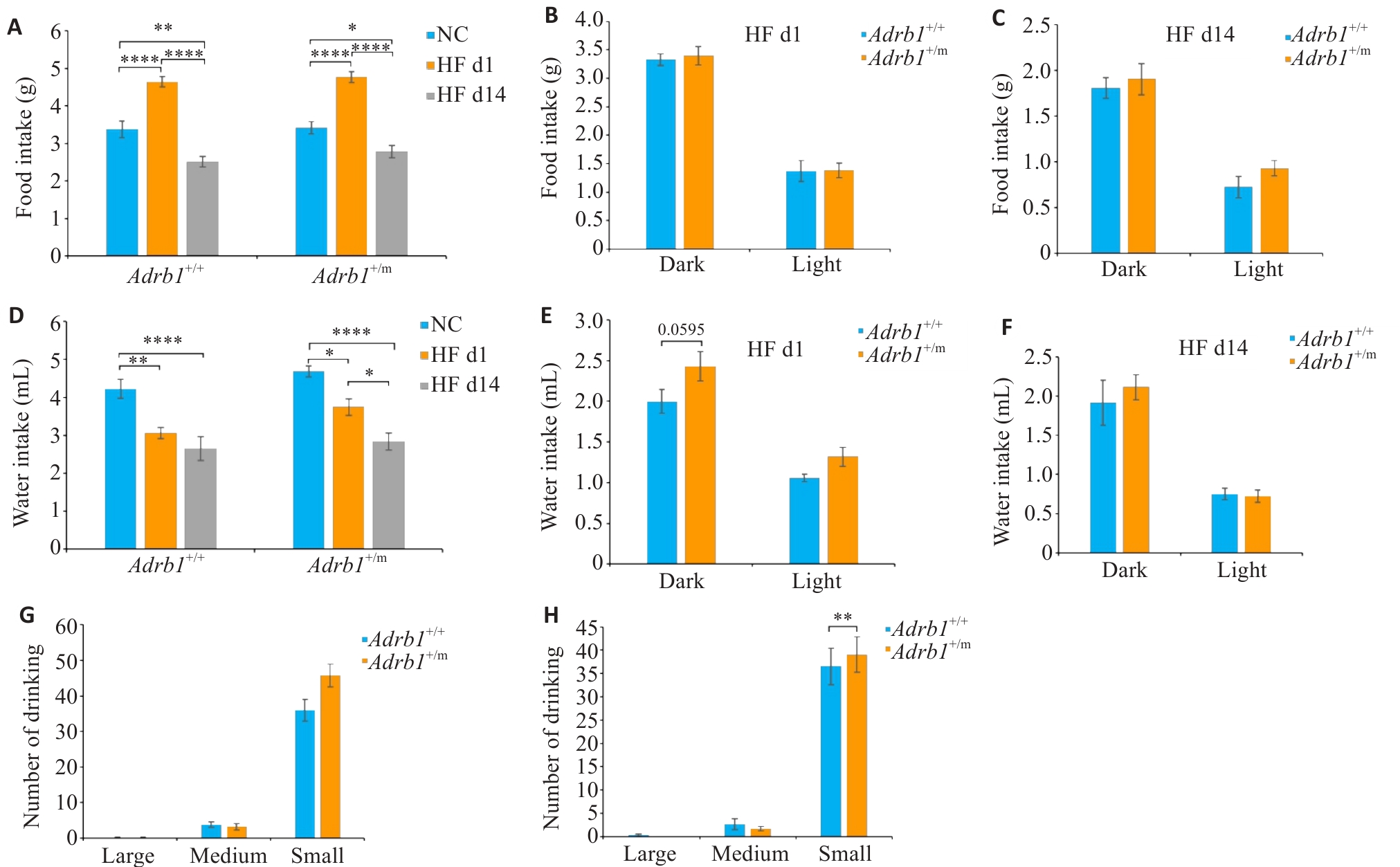
图6 高脂饮食对Adrb1 +/+ 和Adrb1 +/m 小鼠的饮食行为的影响
Fig.6 Effects of high-fat diet (HF) on feeding and drinking behaviors in Adrb1+/+ and Adrb1+/m mice. A: Total daily food intake of Adrb1+/+ and Adrb1+/m mice during NC, HF d1 and HF d14. B: Food intake of Adrb1+/+ and Adrb1+/m mice in the dark and light phase under HF d1. C: Total daily water intake of Adrb1+/+ and Adrb1+/m mice in the dark and light phase under HF d14. D: Total daily water intake of Adrb1+/+ and Adrb1+/m mice during NC、HF d1 and HF d14. E: Water intake of Adrb1+/+ and Adrb1+/m mice in the dark and light phase under HF d1. F: Water intake of Adrb1+/+ and Adrb1+/m mice in the dark and light phase under HF d14. G: Total daily number of "big water", "medium water " and "small water " of Adrb1+/+ and Adrb1+/m mice under HF d1 conditions. H: Total daily number of "big water", " medium water " and "small water " in Adrb1+/+ and Adrb1+/m mice under HF d14 conditions. Adrb1+/+ mice (n=6), Adrb1+/m mice (n=7, except n=4 for drinking at HF d14, E G I), *P<0.05, **P<0.01, ***P<0.001, ****P<0.0001.
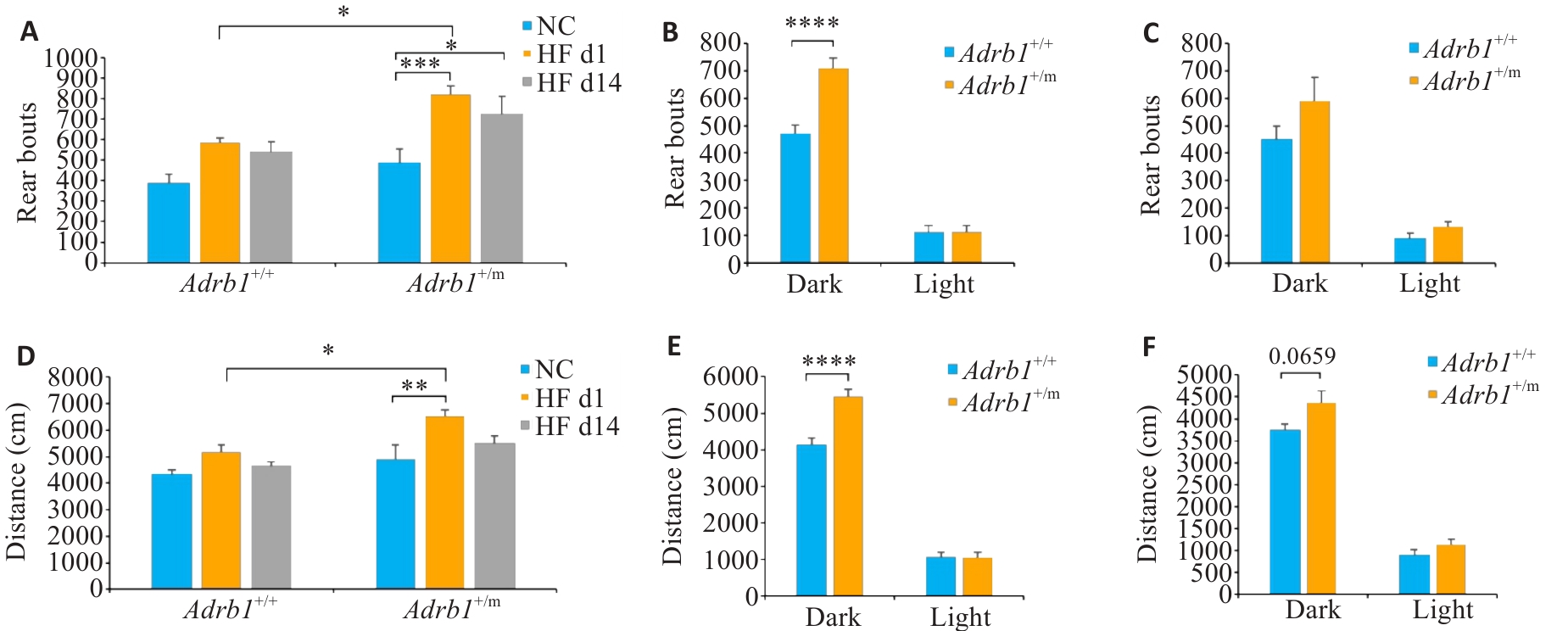
图7 高脂饮食对Adrb1+/+ 和Adrb1 +/m 小鼠的运动行为的影响
Fig.7 Effects of high-fat diet (HF) on locomotor activity of Adrb1+/+ and Adrb1+/m mice. A: Total daily number of rears of Adrb1+/+ and Adrb1+/m mice during NC, HF d1 and HF d14. B: Rear bouts of Adrb1+/+ and Adrb1+/m mice in the dark and light phase under HF d1. C: Rear bouts of Adrb1+/+ and Adrb1+/m mice in the dark and light phase under HF d14. D: Total daily distance traveled by Adrb1+/+ and Adrb1+/m mice under NC, HF D1 and HF d14. E: Distance traveled by Adrb1+/+ and Adrb1+/m mice in the dark and light phase under HF d1. F: Distance traveled by Adrb1+/+ and Adrb1+/m mice in the dark and light phase under HF d14. Adrb1+/+ mice (n=6), Adrb1+/m mice (n=7), *P<0.05, **P<0.01, ***P<0.001, ****P<0.0001.
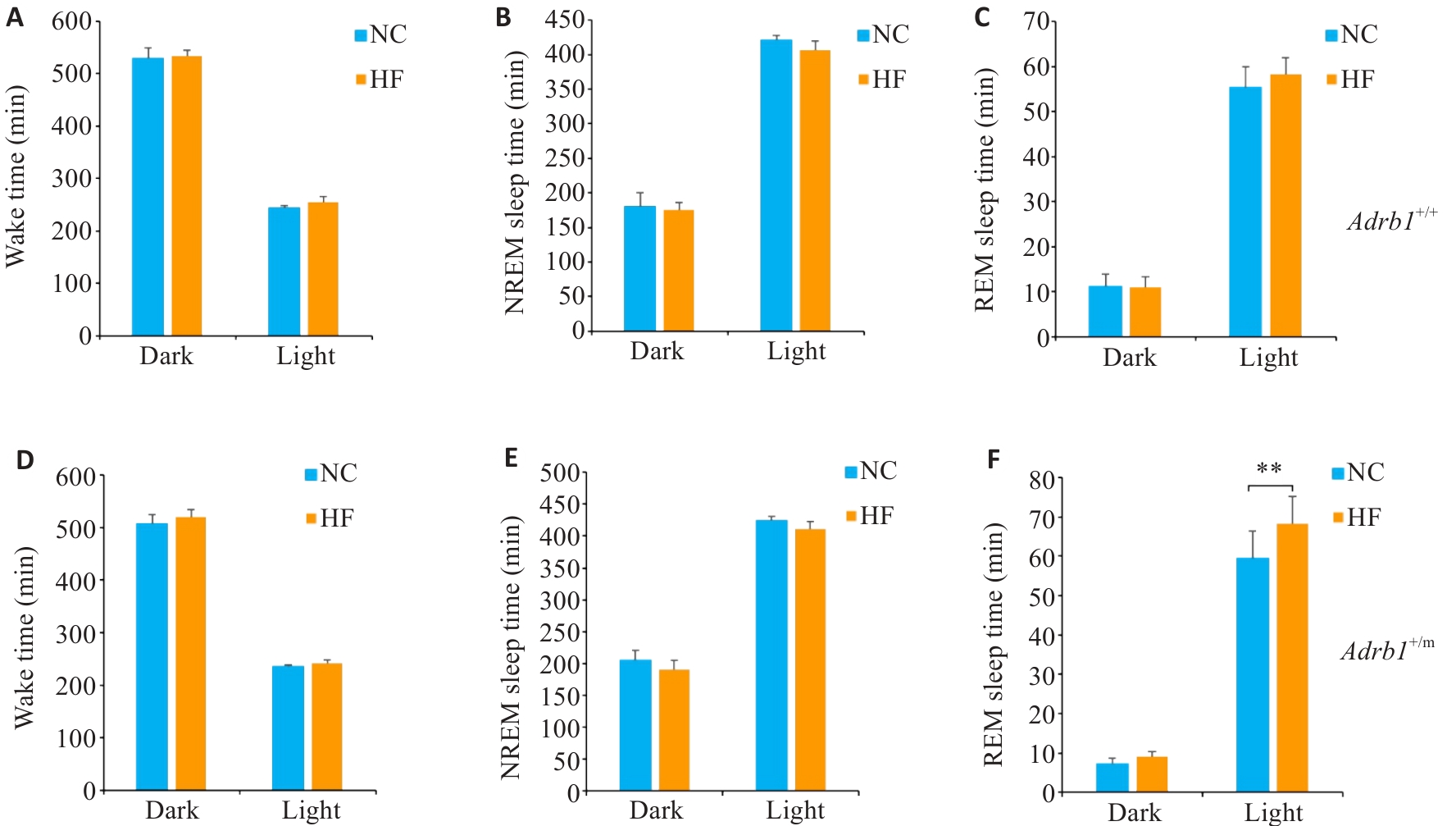
图8 高脂饮食条件下Adrb1 +/+ 和Adrb1 +/m 小鼠的睡眠活动变化
Fig.8 Sleep changes in Adrb1+/+ and Adrb1+/m mice under high-fat diet (HF) condition. A-C: Total Wake (A), NREM (B), and REM (C) sleep time in Adrb1+/+ mice in the dark and light phase under NC and HF conditions. D-F: Total Wake (D), NREM (E), and REM (F) sleep time in Adrb1+/m mice in the dark and light phase under NC and HF conditions. Data are presented as Mean±SE (n=6). **P<0.01.
| 1 | Zuraikat FM, Wood RA, Barragán R, et al. Sleep and diet: mounting evidence of a cyclical relationship[J]. Annu Rev Nutr, 2021, 41: 309-32. |
| 2 | Shukla C, Basheer R. Metabolic signals in sleep regulation: recent insights[J]. Nat Sci Sleep, 2016, 8: 9-20. |
| 3 | Panagiotou M, Meijer JH, Deboer T. Chronic high-caloric diet modifies sleep homeostasis in mice[J]. Eur J Neurosci, 2018, 47(11): 1339-52. |
| 4 | Luppi M, Al-Jahmany AA, del Vecchio F, et al. Wake-sleep and cardiovascular regulatory changes in rats made obese by a high-fat diet[J]. Behav Brain Res, 2017, 320: 347-55. |
| 5 | Kang J, Park M, Oh CM, et al. High-fat diet-induced dopaminergic dysregulation induces REM sleep fragmentation and ADHD-like behaviors[J]. Psychiatry Res, 2023, 327: 115412. |
| 6 | dos Santos SO, Arias J, Ribeiro AA, et al. Incrimination of Lutzomyia cruzi as a vector of American visceral leishmaniasis[J]. Med Vet Entomol, 1998, 12(3): 315-7. |
| 7 | Theorell-Haglöw J, Lemming EW, Michaëlsson K, et al. Sleep duration is associated with healthy diet scores and meal patterns: results from the population-based EpiHealth study[J]. J Clin Sleep Med, 2020, 16(1): 9-18. |
| 8 | Chaput JP, McHill AW, Cox RC, et al. The role of insufficient sleep and circadian misalignment in obesity[J]. Nat Rev Endocrinol, 2023, 19(2): 82-97. |
| 9 | Cheng FW, Li YP, Winkelman JW, et al. Probable insomnia is associated with future total energy intake and diet quality in men[J]. Am J Clin Nutr, 2016, 104(2): 462-9. |
| 10 | Mossavar-Rahmani Y, Weng J, Wang R, et al. Actigraphic sleep measures and diet quality in the Hispanic Community Health Study/Study of Latinos Sueño ancillary study[J]. J Sleep Res, 2017, 26(6): 739-46. |
| 11 | Fenton S, Burrows TL, Skinner JA, et al. The influence of sleep health on dietary intake: a systematic review and meta-analysis of intervention studies[J]. J Hum Nutr Diet, 2021, 34(2): 273-85. |
| 12 | Markwald RR, Melanson EL, Smith MR, et al. Impact of insufficient sleep on total daily energy expenditure, food intake, and weight gain[J]. Proc Natl Acad Sci U S A, 2013, 110(14): 5695-700. |
| 13 | Morselli L, Leproult R, Balbo M, et al. Role of sleep duration in the regulation of glucose metabolism and appetite[J]. Best Pract Res Clin Endocrinol Metab, 2010, 24(5): 687-702. |
| 14 | Penev PD. Sleep deprivation and energy metabolism: to sleep, perchance to eat[J]? Curr Opin Endocrinol Diabetes Obes, 2007, 14(5): 374-81. |
| 15 | Watson NF, Badr MS, Belenky G, et al. Recommended amount of sleep for a healthy adult: a joint consensus statement of the American academy of sleep medicine and sleep research society[J]. Sleep, 2015, 38(6): 843-4. |
| 16 | Hirshkowitz M, Whiton K, Albert SM, et al. National Sleep Foundation's sleep time duration recommendations: methodology and results summary[J]. Sleep Health, 2015, 1(1): 40-3. |
| 17 | Shi GS, Xing LJ, Wu D, et al. A rare mutation of β1-adrenergic receptor affects sleep/wake behaviors[J]. Neuron, 2019, 103(6): 1044-55. e7. |
| 18 | Kjaerby C, Andersen M, Hauglund N, et al. Memory-enhancing properties of sleep depend on the oscillatory amplitude of norepinephrine[J]. Nat Neurosci, 2022, 25(8): 1059-70. |
| 19 | Poe GR, Foote S, Eschenko O, et al. Locus coeruleus: a new look at the blue spot[J]. Nat Rev Neurosci, 2020, 21(11): 644-59. |
| 20 | Berridge CW, Schmeichel BE, España RA. Noradrenergic modulation of wakefulness/arousal[J]. Sleep Med Rev, 2012, 16(2): 187-97. |
| 21 | Szabadi E. Functional neuroanatomy of the central noradrenergic system[J]. J Psychopharmacol, 2013, 27(8): 659-93. |
| 22 | Abell TL, Bernstein RK, Cutts T, et al. Treatment of gastroparesis: a multidisciplinary clinical review[J]. Neurogastroenterol Motil, 2006, 18(4): 263-83. |
| 23 | Parkman HP, Yates KP, Hasler WL, et al. Dietary intake and nutritional deficiencies in patients with diabetic or idiopathic gastroparesis[J]. Gastroenterology, 2011, 141(2): 486-98, 498. e1-7. |
| 24 | Hassanzadeh S, Saneei P, Keshteli AH, et al. Meal frequency in relation to prevalence of functional dyspepsia among Iranian adults[J]. Nutrition, 2016, 32(2): 242-8. |
| 25 | Holmbäck I, Ericson U, Gullberg B, et al. A high eating frequency is associated with an overall healthy lifestyle in middle-aged men and women and reduced likelihood of general and central obesity in men[J]. Br J Nutr, 2010, 104(7): 1065-73. |
| 26 | Titan SM, Bingham S, Welch A, et al. Frequency of eating and concentrations of serum cholesterol in the Norfolk population of the European prospective investigation into cancer (EPIC-Norfolk): cross sectional study[J]. BMJ, 2001, 323(7324): 1286-8. |
| 27 | Ma YS, Bertone ER, Stanek EJ 3rd, et al. Association between eating patterns and obesity in a free-living US adult population[J]. Am J Epidemiol, 2003, 158(1): 85-92. |
| 28 | Ruidavets JB, Bongard V, Bataille V, et al. Eating frequency and body fatness in middle-aged men[J]. Int J Obes Relat Metab Disord, 2002, 26(11): 1476-83. |
| 29 | Carlson O, Martin B, Stote KS, et al. Impact of reduced meal frequency without caloric restriction on glucose regulation in healthy, normal-weight middle-aged men and women[J]. Metabolism, 2007, 56(12): 1729-34. |
| 30 | Ngo FY, Li HH, Zhang HQ, et al. Acute fasting modulates food-seeking behavior and neural signaling in the piriform cortex[J]. Nutrients, 2022, 14(19): 4156. |
| 31 | Siegel JM. Sleep function: an evolutionary perspective[J]. Lancet Neurol, 2022, 21(10): 937-46. |
| [1] | 董梦璐, 朱恬, 马俊文, 杜晓红, 冯媛. 复氧改善间歇性缺氧所致的肥胖大鼠下丘脑瘦素反应性降低[J]. 南方医科大学学报, 2024, 44(9): 1696-1703. |
| [2] | 钟帷韬, 李伟松, 李泽霖, 王强, 张旺明. 睡眠性状与特发性正常压力脑积水的因果关联:一项两样本双向孟德尔随机化研究[J]. 南方医科大学学报, 2024, 44(8): 1612-1619. |
| [3] | 袁萍, 胡秀莉, 漆国佳, 代秀, 褚相远, 陈卫航, 石修权. 睡眠质量低下与创伤患者创伤后应激障碍的发生相关[J]. 南方医科大学学报, 2024, 44(6): 1166-1172. |
| [4] | 朱继伟, 卢曼路, 焦倩倩, 孙运良, 刘 璐, 丁红红, 于 燕, 潘 磊. 基于16S rRNA测序分析阻塞性睡眠呼吸暂停患者肠道靶标菌群的变化[J]. 南方医科大学学报, 2024, 44(1): 146-155. |
| [5] | 苏小凤, 韩继明, 高莹卉, 范 利, 何子君, 赵 哲, 林俊岭, 郭静静, 陈开兵, 高 燕, 刘 霖. 老年阻塞性睡眠呼吸暂停患者远期缺血性脑卒中的风险评分模型: 多中心前瞻性队列研究[J]. 南方医科大学学报, 2022, 42(3): 338-346. |
| [6] | 古翠方, 翟明见, 吕爱俊, 刘 露, 胡 欢, 刘 溪, 李 璇, 程向阳. 超声引导下的星状神经节阻滞可改善老年肺癌患者胸腔镜术后早期睡眠:86例前瞻性随机对照试验[J]. 南方医科大学学报, 2022, 42(12): 1807-1814. |
| [7] | 韩彬彬, 王闪闪, 李国华, 王学惠, 陈志刚, 赵国安, 陈莹恩, 李 猛, 李 燕, 张 敏, 艾思志. 不同射血分数心力衰竭患者的客观睡眠特征及睡眠呼吸暂停的危险因素[J]. 南方医科大学学报, 2021, 41(9): 1415-1419. |
| [8] | 苏小凤, 韩继明, 高莹卉, 何子君, 赵 哲, 林俊岭, 郭静静, 陈开兵, 高 燕, 刘 霖. 老年阻塞性睡眠呼吸暂停与代谢综合征各组分的相关性及其对远期不良心血管事件发生风险的影响[J]. 南方医科大学学报, 2021, 41(11): 1592-1599. |
| [9] | 邱倩琪, 宋兴荣, 孙昌志, 谭永红, 徐颖怡, 黄桂亮, 张 娜, 李峥科, 魏 伟. 全身麻醉影响4~6岁鼾症儿童术后首夜褪黑素的分泌但不造成抑制[J]. 南方医科大学学报, 2021, 41(1): 128-134. |
| [10] | 高莹卉, 温永飞, 钱小顺, 赵力博, 徐 虎, 徐伟豪, 孔晓萱, 车贺宾, 王亚斌, 刘 霖. 无心血管合并症的老年阻塞性睡眠呼吸暂停综合征患者心功能变化及其影响因素分析[J]. 南方医科大学学报, 2020, 40(11): 1587-1592. |
| [11] | 谭 健, 崔前波, 顾 翔, 许淑芳, 薛 莎, 袁 琨, 陈 伟. 体质量管理联合腭咽成形术治疗肥胖相关性阻塞性睡眠呼吸暂停低通气综合征的疗效观察[J]. 南方医科大学学报, 2020, 40(11): 1668-1672. |
| [12] | 武淑萍,高莹卉,钱小顺,赵力博,徐 虎,徐伟豪,孔晓萱,杨 阳,车贺宾,王亚斌,袁熹娜,刘 霖. 老年阻塞性睡眠呼吸暂停综合征严重度与红细胞体积分布宽度 的相关性[J]. 南方医科大学学报, 2020, 40(05): 703-707. |
| [13] | 盛小燕,刘芬玉,周 瑾,廖荣荣. COVID-19感染爆发期护理实习生的心理状况及睡眠质量调查[J]. 南方医科大学学报, 2020, 40(03): 346-350. |
| [14] | 张蕊蕊,李中林,白莹莹,许鹏飞,张杰文,张红菊. 快速眼动睡眠行为障碍患者大脑结构网络特性的改变[J]. 南方医科大学学报, 2020, 40(01): 125-130. |
| [15] | 梅俊华,张 琦,龚 雪,徐金梅,潘宋斌,潘晓峰,王俊力,刘敏珍,陈国华. 持续性姿势-知觉性头晕患者睡眠障碍与认知功能障碍[J]. 南方医科大学学报, 2020, 40(01): 131-136. |
| 阅读次数 | ||||||
|
全文 |
|
|||||
|
摘要 |
|
|||||